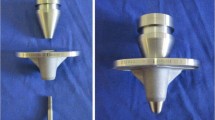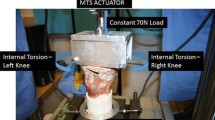Abstract
Pulsatile lavage is purported to improve radiographic survival in cemented total knee arthroplasty (TKA). Similarly, a potential improvement of fixation strength of the tibial tray has been assumed based on the increased cement penetration. In this study, the influence of pulsed lavage on fixation strength of the tibial component and bone cement penetration was evaluated in six pairs of cadaveric specimens. Following surgical preparation, the tibial surface was irrigated using pulsatile lavage on one side of a pair, while on the other side syringe lavage was applied. All tibial components were implanted using the same cementing technique. Cement penetration and bone mineral density was assessed based on computed tomography data. Fixation strength of the tibial trays was determined by a pull-out test with a material testing machine. Median pull-out forces and cement penetration were significantly (p = 0.031) improved in the pulsed lavage group as compared to the syringe lavage group. Enhanced fixation strength is suggested as being a key to improved survival of the implant. Consequently, pulsatile lavage should be considered as a mandatory preparation step when cementing tibial components in TKA.




Similar content being viewed by others
References
Askew MJ, Steege JW, Lewis JL, Ranieri JR, Wixson RL (1984) Effect of cement pressure and bone strength on polymethylmethacrylate fixation. J Orthop Res 1:412–420
Breusch SJ, Norman TL, Schneider U, Reitzel T, Blaha JD, Lukoschek M (2000) Lavage technique in total hip arthroplasty: jet lavage produces better cement penetration than syringe lavage in the proximal femur. J Arthroplasty 15:921–927
Clarius M, Hauck C, Seeger JB, James A, Murray DW, Aldinger PR (2009) Pulsed lavage reduces the incidence of radiolucent lines under the tibial tray of Oxford unicompartmental knee arthroplasty: pulsed lavage versus syringe lavage. Int Orthop 33:1585–1590
Dalury DF, Pomeroy DL, Gonzales RA, Gruen TA, Adams MJ, Empson JA (2009) Midterm results of all-polyethylene tibial components in primary total knee arthroplasty. J Arthroplasty 24:620–624
Davies JP, Harris WH (1994) Tensile bonding strength of the cement-prosthesis interface. Orthopedics 17:171–173
Dixon MC, Brown RR, Parsch D, Scott RD (2005) Modular fixed-bearing total knee arthroplasty with retention of the posterior cruciate ligament. A study of patients followed for a minimum of fifteen years. J Bone Joint Surg Am 87:598–603
Fetzer GB, Callaghan JJ, Templeton JE, Goetz DD, Sullivan PM, Kelley SS (2002) Posterior cruciate-retaining modular total knee arthroplasty: a 9- to 12-year follow-up investigation. J Arthroplasty 17:961–966
Furnes O, Espehaug B, Lie SA, Vollset SE, Engesaeter LB, Havelin LI (2002) Early failures among 7,174 primary total knee replacements: a follow-up study from the Norwegian Arthroplasty Register 1994–2000. Acta Orthop Scand 73:117–129
Guha AR, Debnath UK, Graham NM (2008) Radiolucent lines below the tibial component of a total knee replacement (TKR)—a comparison between single-and two-stage cementation techniques. Int Orthop 32:453–457
Herberts P, Malchau H (2000) Long-term registration has improved the quality of hip replacement: a review of the Swedish THR Register comparing 160,000 cases. Acta Orthop Scand 71:111–121
Huiskes R, Sloof TJ (1981) Thermal injury of cancellous bone following pressured penetration of acrylic cement. Trans Orthop Res Soc 6:134
Kalteis T, Pforringer D, Herold T, Handel M, Renkawitz T, Plitz W (2007) An experimental comparison of different devices for pulsatile high-pressure lavage and their relevance to cement intrusion into cancellous bone. Arch Orthop Trauma Surg 127:873–877
Khaw FM, Kirk LM, Morris RW, Gregg PJ (2002) A randomised, controlled trial of cemented versus cementless press-fit condylar total knee replacement. Ten-year survival analysis. J Bone Joint Surg Br 84:658–666
Kopec M, Milbrandt JC, Duellman T, Mangan D, Allan DG (2009) Effect of hand packing versus cement gun pressurization on cement mantle in total knee arthroplasty. Can J Surg 52:490–494
Labutti RS, Bayers-Thering M, Krackow KA (2003) Enhancing femoral cement fixation in total knee arthroplasty. J Arthroplasty 18:979–983
Lachiewicz PF, Soileau ES (2004) The rates of osteolysis and loosening associated with a modular posterior stabilized knee replacement. Results at five to fourteen years. J Bone Joint Surg Am 86-A:525–530
Lutz MJ, Halliday BR (2002) Survey of current cementing techniques in total knee replacement. ANZ J Surg 72:437–439
Lutz MJ, Pincus PF, Whitehouse SL, Halliday BR (2009) The effect of cement gun and cement syringe use on the tibial cement mantle in total knee arthroplasty. J Arthroplasty 24:461–467
MacDonald W, Swarts E, Beaver R (1993) Penetration and shear strength of cement-bone interfaces in vivo. Clin Orthop Relat Res 286:283–288
Maistrelli GL, Antonelli L, Fornasier V, Mahomed N (1995) Cement penetration with pulsed lavage versus syringe irrigation in total knee arthroplasty. Clin Orthop Relat Res 312:261–265
Mann KA, Ayers DC, Werner FW, Nicoletta RJ, Fortino MD (1997) Tensile strength of the cement-bone interface depends on the amount of bone interdigitated with PMMA cement. J Biomech 30:339–346
Parks NL, Engh GA, Topoleski LD, Emperado J (1998) The Coventry Award. Modular tibial insert micromotion. A concern with contemporary knee implants. Clin Orthop Relat Res 356:10–15
Parsch D, Kruger M, Moser MT, Geiger F (2009) Follow-up of 11-16 years after modular fixed-bearing TKA. Int Orthop 33:431–435
Peters CL, Craig MA, Mohr RA, Bachus KN (2003) Tibial component fixation with cement: full- versus surface-cementation techniques. Clin Orthop Relat Res 409:158–168
Pittman GT, Peters CL, Hines JL, Bachus KN (2006) Mechanical bond strength of the cement-tibial component interface in total knee arthroplasty. J Arthroplasty 21:883–888
Rea P, Short A, Pandit H, Price AJ, Kyberd P, Beard DJ, Gill HS, Murray DW (2007) Radiolucency and migration after Oxford unicompartmental knee arthroplasty. Orthopedics 30:24–27
Ritter MA, Herbst SA, Keating EM, Faris PM (1994) Radiolucency at the bone-cement interface in total knee replacement. The effects of bone-surface preparation and cement technique. J Bone Joint Surg Am 76:60–65
Rodriguez JA, Baez N, Rasquinha V, Ranawat CS (2001) Metal-backed and all-polyethylene tibial components in total knee replacement. Clin Orthop Relat Res 392:174–183
Smith S, Naima VS, Freeman MA (1999) The natural history of tibial radiolucent lines in a proximally cemented stemmed total knee arthroplasty. J Arthroplasty 14:3–8
Vanlommel J, Luyckx JP, Labey L, Innocenti B, De Corte R, Bellemans J (2010) Cementing the tibial component in total knee arthroplasty which technique is the best? J Arthroplasty. April 7 [Epub ahead of print]
Walker PS, Soudry M, Ewald FC, McVickar H (1984) Control of cement penetration in total knee arthroplasty. Clin Orthop Relat Res 185:155–164
Weiss RJ, Heisel C, Breusch SJ (2003) Patellar component stability improves with pulsatile lavage in total knee arthroplasty. Int Orthop 27:18–21
Acknowledgments
Financial support and implants for this study were provided by DePuy Orthopaedics.
Author information
Authors and Affiliations
Corresponding author
Rights and permissions
About this article
Cite this article
Schlegel, U.J., Siewe, J., Delank, K.S. et al. Pulsed lavage improves fixation strength of cemented tibial components. International Orthopaedics (SICOT) 35, 1165–1169 (2011). https://doi.org/10.1007/s00264-010-1137-y
Received:
Revised:
Accepted:
Published:
Issue Date:
DOI: https://doi.org/10.1007/s00264-010-1137-y




